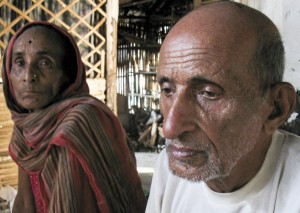Will they rejoin their sons?
In the case you ever visit the Bhutanese refugee camp in Jhapa district, Nepal at Beldangi II, Sector I-1, Hut No 39, the first question you will be asked is whether you are the one who will take them to see their sons.
The aged couple, Ram Chandra Guragai, 73, and Yasoda, 69, are living on the good will of their neighbors. Simple and essential tasks such as fetching water from the nearby tap and preparing meals are no longer possible for them most of the time. People age all over the world, and in Bhutanese refugee society the elderly are usually cared for by the families of their children. For Ram Chandra and Yasoda, however, this care is a dream, as their family is about 10,000 miles away.
Two years ago the Guragai family started the resettlement process. As a family they faced the violent mass exodus from Bhutan. As a family they endured 18 years of struggle and poverty in the refugee camps of south-eastern Nepal. And as a family they dreamed of a new beginning when they were offered the chance to seek resettlement to a third country. This dream has proven to be elusive, however, as the family has been scattered around the world, leaving the two elders behind.
Six months ago their eldest son left for Australia. The youngest son left four months ago, also to Australia. Two married daughters have already left for the USA, and the only remaining support, one of their daughters who is also no longer living with them as she is also married, is scheduled to leave for Canada in the next few days.
“We can’t understand why we are left in the camp.” says Ram Chandra, his wife reading his lips as she is hard of hearing. The aged couple fears that they might not see their family again. “We might die without seeing our sons”, Ram Chandra adds, sadly lowering his gaze, unable to change the whims of the Australian authorities. After filing paperwork declaring their interest for resettlement, numerous interviews and two medical exams, they finally received the clearance needed for resettlement one year ago, but still they have not been given a departure date. They sit and wait while they whither away, unable to care for themselves.
According to Ram Chandra, his sons, worrying in Australia, tried to appeal to the Department of Immigration and Citizenship (DIAC) to be reunited with their parents at the earliest, but were briskly sent away, told not to come again.
When asked whether his family is supporting them, Ram Chandra replies “So far we have received at least 15,000 Nepalese rupees [aprox. 200 $], but we now know that money is nothing. Our situation is worsening day by day, while we still cannot do anything”.
The entire process of resettlement was initiated with the intention of reducing the suffering of the exiled Bhutanese. After the mass exodus from Bhutan and 18 unfruitful years in refugee camps, the ordeal of the Australian bureaucracy is another hurdle for this displaced people.
When asked to comment on whether there was any role of his office in this delay, the chief of the International Organization for Migration in Damak, David Derthick, says “We only do the medical exams and handle booking requests by the DIAC”.
An estimated 108.000 people from southern Bhutan are bunched in seven refugee camps in two of the eastern districts of Nepal under UNHCR supervision. Displaced from their homes due to racial violence and oppression in the early 1990’s, so far not a single refugee has been able to return to their previous homeland.
With repatriation not feasible under the current circumstances, in 2006 they were offered the possibility of resettling in seven different countries (USA, Australia, Denmark, Canada, New Zealand, The Netherlands and Norway). Due to the conditions in the camps, which provide little prospects for the future, more than 65.000 have already declared their interest in being resettled.
Australia alone has committed to accepting at least 5000 refugees, probable relief for many. 720 individuals have so far been resettled there. However, the case of Ram Chandra and Yasoda, along with many others, indicates that this process needs to be handled delicately; there is much to be done on part of the authorities in order to improve the process.
Especially when dealing with an issue as delicate as the relocation of families already traumatized by an extensive refugee experience, agencies and governments need to be sure they properly assess and ensure the needs of all individuals are met during the resettlement process. Failure to do so increases the trauma and stress of people who have already suffered enormous amounts of both through their lengthy ordeal as refugees.
A 90-year old from the same camp, Dhanapati Poudyel, was taken to Australia on May 17, 2009. “My grandfather is finally being resettled, with a doctor accompanying him”, his grandson says, “Although the process of settlement took nearly two years from its beginning and was a bit frustrating for us”. The refugees deserve to be treated with this respect and attention to their needs. Leaving vulnerable people in the camps and long and stressful resettlement processes are woes that cannot be placed on their shoulders.
But yet the question arises: will the Guragai couple be able to join their sons soon? Or will the wait take even longer?
(Mishra works with Bhutan News Service, D. Horn is Austrian Freelancer and B. Peterson works with Green Left Weekly, Australia)

